Project Vita
Project Vita is a non-profit organization that carries out development projects in East Africa. Their focus is on improving the standards of living for people living in Mozambique. The organization believes in strengthening and supporting local communities so that they have the tools to improve their living standards and society themselves.
By bringing together different cultures and communities, Project Vita increases prosperity in various areas of Mozambique. They encourage involvement and engagement at a grassroots level and focus on creating a platform to share and develop knowledge, as well as to learn about and understand each other’s cultures. In this way, they build a foundation for long term change.
By bringing together different cultures and communities, Project Vita increases prosperity in various areas of Mozambique. They encourage involvement and engagement at a grassroots level and focus on creating a platform to share and develop knowledge, as well as to learn about and understand each other’s cultures. In this way, they build a foundation for long term change.
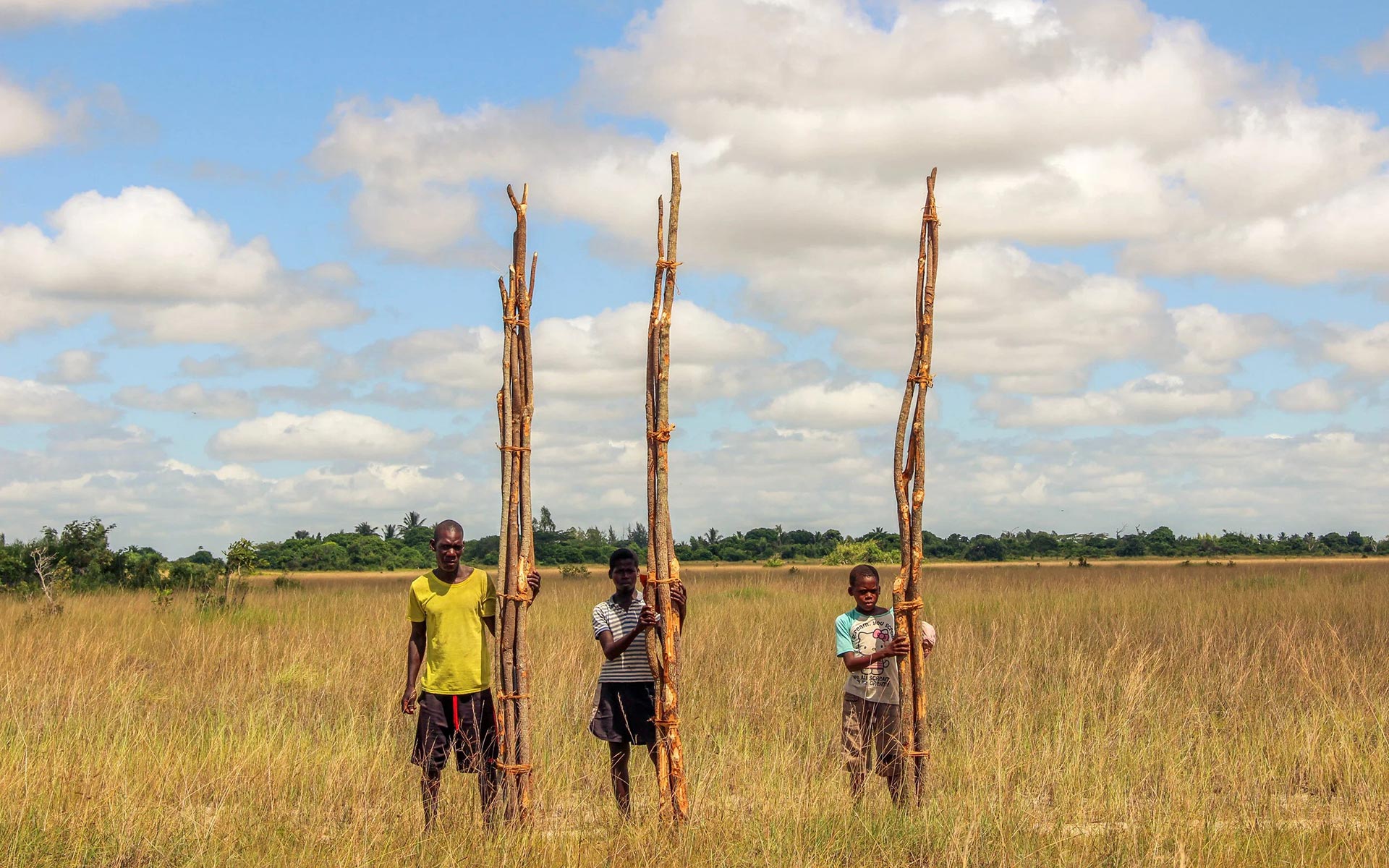
Summary
The organization was founded by a Swedish man, and its pilot project was launched in 2015, with the goal of finding affordable solutions to improve building methods without using expensive or imported materials. Their focus is on sharing knowledge and creating long-term solutions instead of providing constant aid. Their philosophy is best understood via their quote: A hand up, not a handout.
The projects carried out by Project Vita are funded and carried out by companies, private individuals and student work. The organization has now begun to conduct most of it projects in collaboration with companies that want to contribute to charity. This allows them to set long-term goals to a greater extent, implement larger projects, and have a more stable economy.
The challenge they have is reaching out to companies that are interested in engaging in charitable work in line with their philosophy. It has also been difficult for companies to find non-profit organizations that they feel confident in supporting, especially if they are smaller organizations. This is problematic since this type of collaboration can lead to cost-effective and large projects. Therefore, project Vita came to us to help them understand what companies are looking for in terms of information on their website and social media to create and develop a trusting relationship between their potential partners and themselves.
Our contact from Project Vita specifically asked us to research and provide answers to these questions:
1. What do companies need to feel confident about creating a partnership with a non-profit organization?
2. How do companies want to conduct their charitable work?
3. What kind of information do companies want to find on the organization’s website and social media?
4. How can Project Vita create and maintain trust between them and the companies that want to work with them?
The projects carried out by Project Vita are funded and carried out by companies, private individuals and student work. The organization has now begun to conduct most of it projects in collaboration with companies that want to contribute to charity. This allows them to set long-term goals to a greater extent, implement larger projects, and have a more stable economy.
The challenge they have is reaching out to companies that are interested in engaging in charitable work in line with their philosophy. It has also been difficult for companies to find non-profit organizations that they feel confident in supporting, especially if they are smaller organizations. This is problematic since this type of collaboration can lead to cost-effective and large projects. Therefore, project Vita came to us to help them understand what companies are looking for in terms of information on their website and social media to create and develop a trusting relationship between their potential partners and themselves.
Our contact from Project Vita specifically asked us to research and provide answers to these questions:
1. What do companies need to feel confident about creating a partnership with a non-profit organization?
2. How do companies want to conduct their charitable work?
3. What kind of information do companies want to find on the organization’s website and social media?
4. How can Project Vita create and maintain trust between them and the companies that want to work with them?
Research process
We used several methods to carry out our research. We first started by researching Project Vita by looking into their website and social media. We gathered information about how they currently presented themselves to the world and created a mural board to help us organize what information they currently had available publicly.
We also examined Project Vita’s pain points and narrowed them down to 3 main problems:
1. Difficulties in reaching out to other companies.
2. A hard time understanding how to build a trusting and confident professional partnership
3. The company is a smaller non-profit, which comes with many challenges including being unknown and as such untrustworthy to many.
We also examined Project Vita’s pain points and narrowed them down to 3 main problems:
1. Difficulties in reaching out to other companies.
2. A hard time understanding how to build a trusting and confident professional partnership
3. The company is a smaller non-profit, which comes with many challenges including being unknown and as such untrustworthy to many.
Methods
With a clear view of who Project Vita was today, we delved into the main user research. It was at this point that we quickly realized that it was difficult to define who our users were. Even though we had already defined our stakeholders, it was a bit harder to define a specific user that we would then conduct our research on as we couldn’t exactly consider a whole company as our user in this case. In the end, we defined the user as a person at a company with a decision-making role.
From that point on we were able to create a survey that we send out to our potential users. We also conducted 4 in-depth interviews via zoom lasting anywhere between 30 and 45 minutes. We then transcribed the interviews and color-marked all relevant information to be able to carry out a more in-depth analysis. From the information we gathered, we created an affinity diagram, an empathy map and a persona. These methods allowed us to come to several insights and answers to the questions posed by our client.
From that point on we were able to create a survey that we send out to our potential users. We also conducted 4 in-depth interviews via zoom lasting anywhere between 30 and 45 minutes. We then transcribed the interviews and color-marked all relevant information to be able to carry out a more in-depth analysis. From the information we gathered, we created an affinity diagram, an empathy map and a persona. These methods allowed us to come to several insights and answers to the questions posed by our client.
Survey
The client sees an opportunity to gain market share by offering a new service that differentiates itself from competitors in two ways: First, by offering a more focused product experience compared to competitors which means focusing solely on grocery shopping from its own store, completely excluding restaurant orders or purchases from physical convenience stores.
Second, by offering an experience that is entirely focused on quick grocery shopping. The app will need to emphasize simplicity, speed, and a streamlined shopping experience. By helping people with extremely limited time act faster and more easily than through any other provider.
Second, by offering an experience that is entirely focused on quick grocery shopping. The app will need to emphasize simplicity, speed, and a streamlined shopping experience. By helping people with extremely limited time act faster and more easily than through any other provider.
Survey highlights
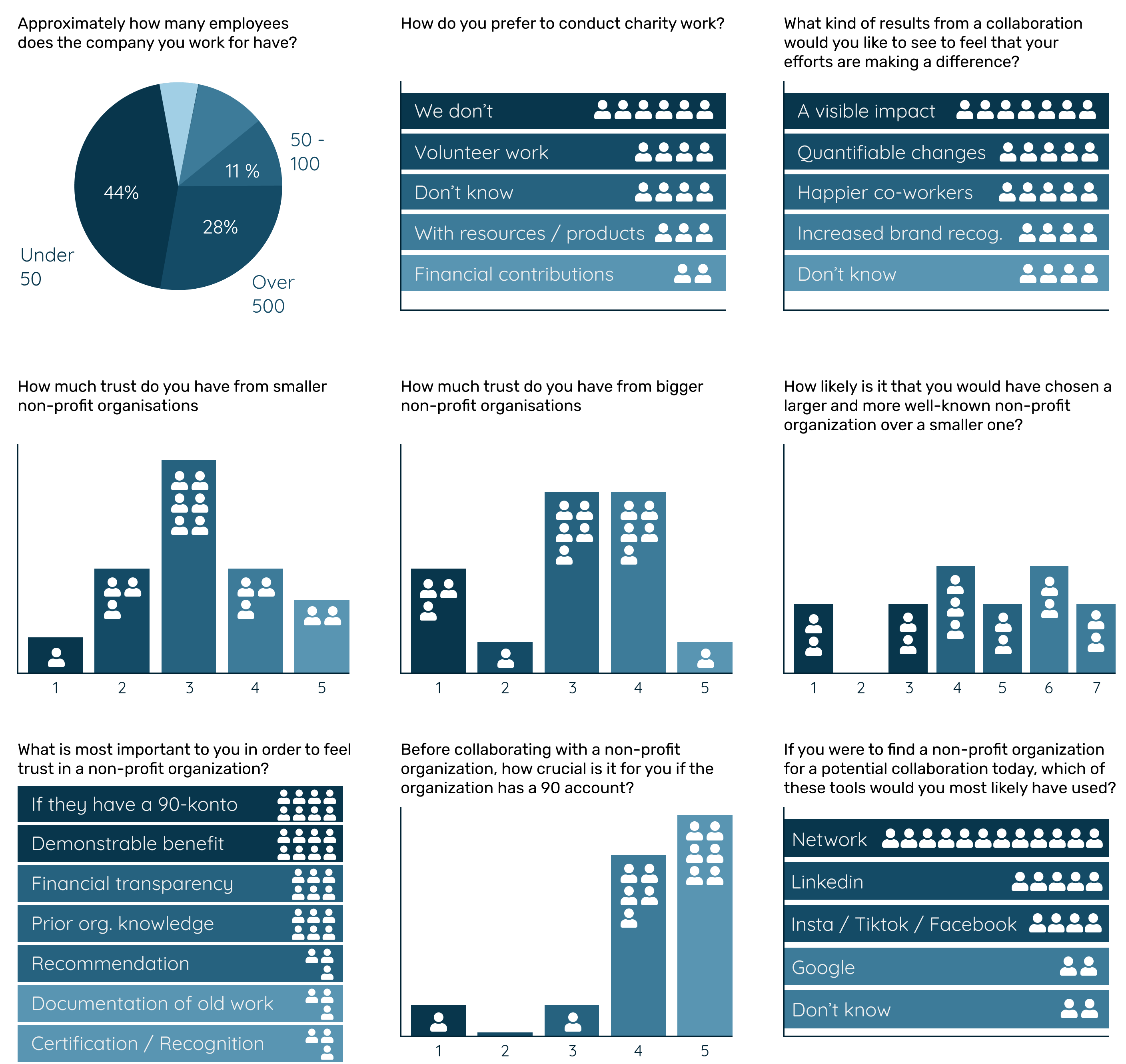
Survey conclusions
1. A user’s personal network is the primary method they look for non-profit organizations to support.
2. There is a moderate amount of trust in smaller nonprofit organizations.
3. Having a 90-konto is very important and outweighs the cons required in obtaining one. (A 90-konto is an account used by non-profit organizations and is a seal of quality that guarantees that the organization is reputable. It is regulated by the independent body “Svensk Insamlingskontroll”)
4. Familiarity breeds trust.
5. Thorough documentation of results is expected on the non-profit's website.
6. A demonstrable societal benefit, via documentation including photos and videos provides reassurance and increases trust in the organization.
7. The amount of knowledge about non-profit organizations varies greatly from person to person.
2. There is a moderate amount of trust in smaller nonprofit organizations.
3. Having a 90-konto is very important and outweighs the cons required in obtaining one. (A 90-konto is an account used by non-profit organizations and is a seal of quality that guarantees that the organization is reputable. It is regulated by the independent body “Svensk Insamlingskontroll”)
4. Familiarity breeds trust.
5. Thorough documentation of results is expected on the non-profit's website.
6. A demonstrable societal benefit, via documentation including photos and videos provides reassurance and increases trust in the organization.
7. The amount of knowledge about non-profit organizations varies greatly from person to person.
Interviews
We carried out four in-depth interviews. These were conducted remotely with people from different companies and industries. The purpose of these interviews was to gather more qualitative data for our research. Below are some interview highlights that are related to the questions we were requested to answer by Project Vita.
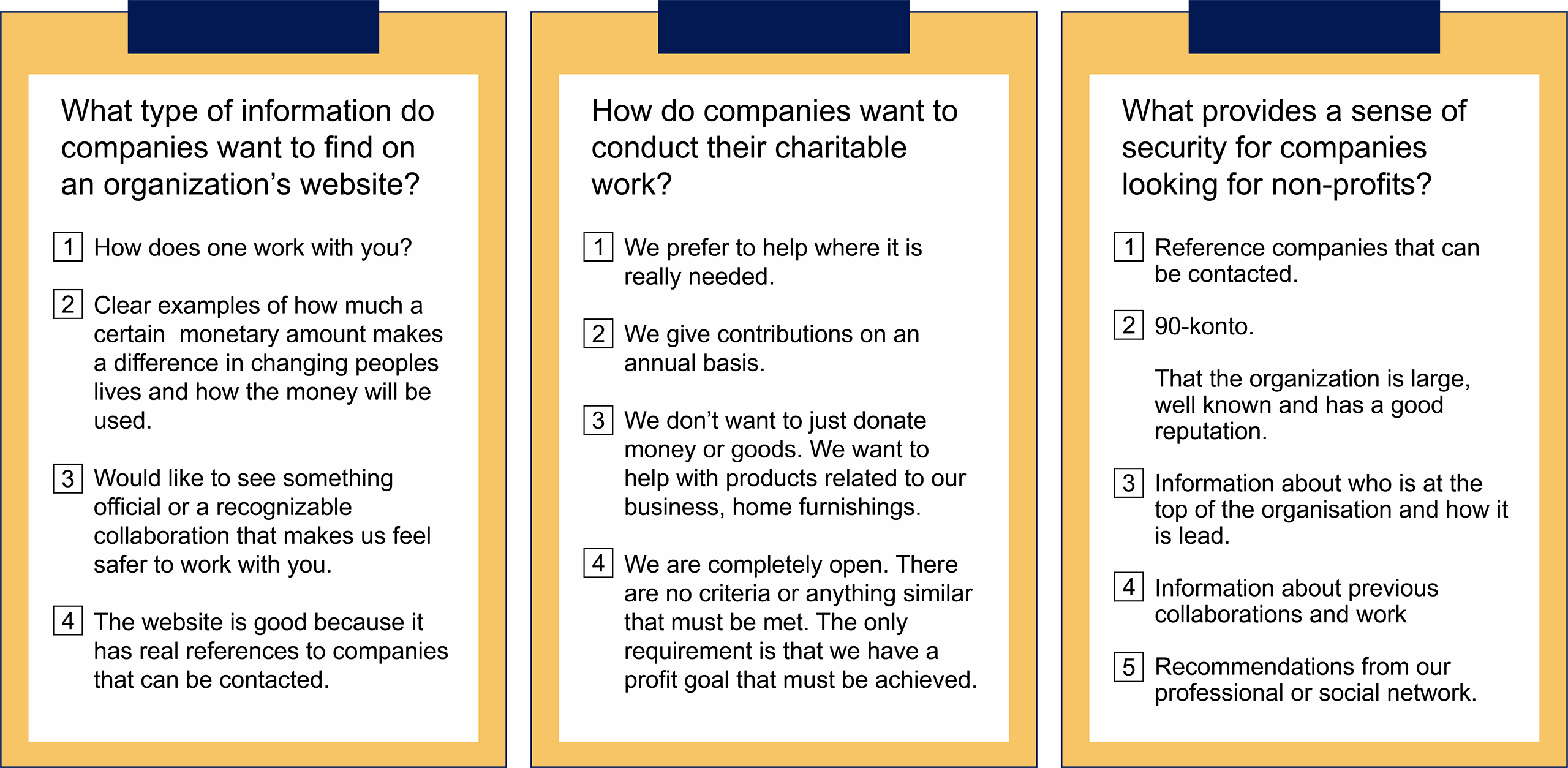
Interview conclusions
1. There is a lot of uncertainty about whether donations go to their intended purpose.
2. The history of media scandals where various non-profits have been involved in different types of fraud or scams strongly damages trust, even for organizations that were not involved. It is also difficult to regain that trust once it has been damaged.
3. There is a lot of variation in how and how much companies want to support non-profits, but we noticed a trend where the majority prefer to contribute with resources rather than money.
4. Most companies have stated that the way they find organizations is through recommendations within their professional and personal network, which provides a more stable collaboration.
5. Other factors that increase feelings of trust and security are: documentation from previous collaborations, transparency about the organization’s operations and leadership, and that the organization holds a 90-konto (However, a 90-account has not always been a requirement, rather it is a plus that gives reassurance that the organization is monitored)
2. The history of media scandals where various non-profits have been involved in different types of fraud or scams strongly damages trust, even for organizations that were not involved. It is also difficult to regain that trust once it has been damaged.
3. There is a lot of variation in how and how much companies want to support non-profits, but we noticed a trend where the majority prefer to contribute with resources rather than money.
4. Most companies have stated that the way they find organizations is through recommendations within their professional and personal network, which provides a more stable collaboration.
5. Other factors that increase feelings of trust and security are: documentation from previous collaborations, transparency about the organization’s operations and leadership, and that the organization holds a 90-konto (However, a 90-account has not always been a requirement, rather it is a plus that gives reassurance that the organization is monitored)
Affinity diagram from interview and survey results
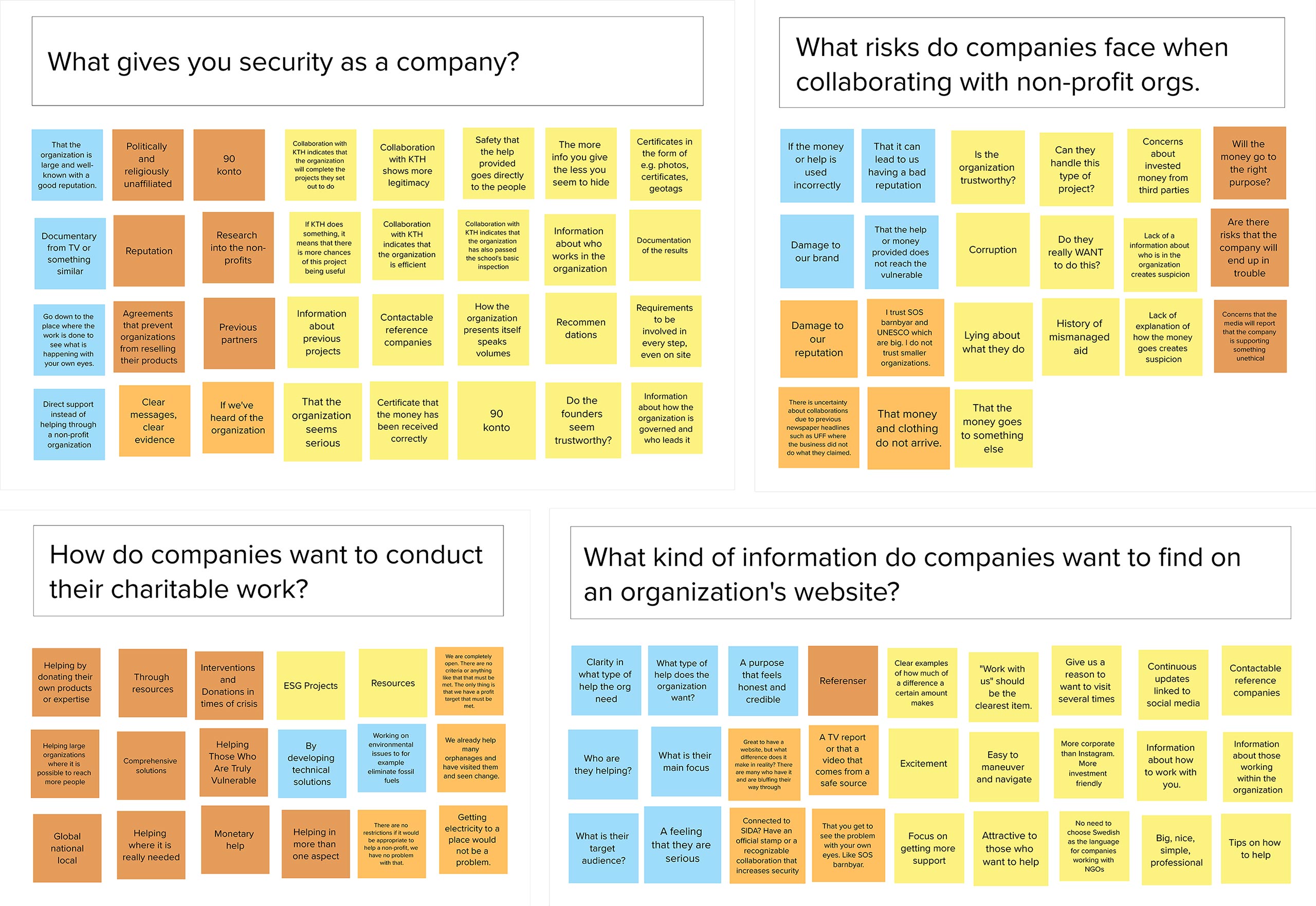
Empathy map and Persona
Two method we employed to create a clearer picture of our target audience are an empathy map and a persona.
Robert Frisk, our persona became the fictional representative of Project Vita’s ideal user, based on the information we have gathered. The purpose with these methods is to increase empathy and understanding on a concrete level for the project’s needs and paint points.
Robert Frisk, our persona became the fictional representative of Project Vita’s ideal user, based on the information we have gathered. The purpose with these methods is to increase empathy and understanding on a concrete level for the project’s needs and paint points.
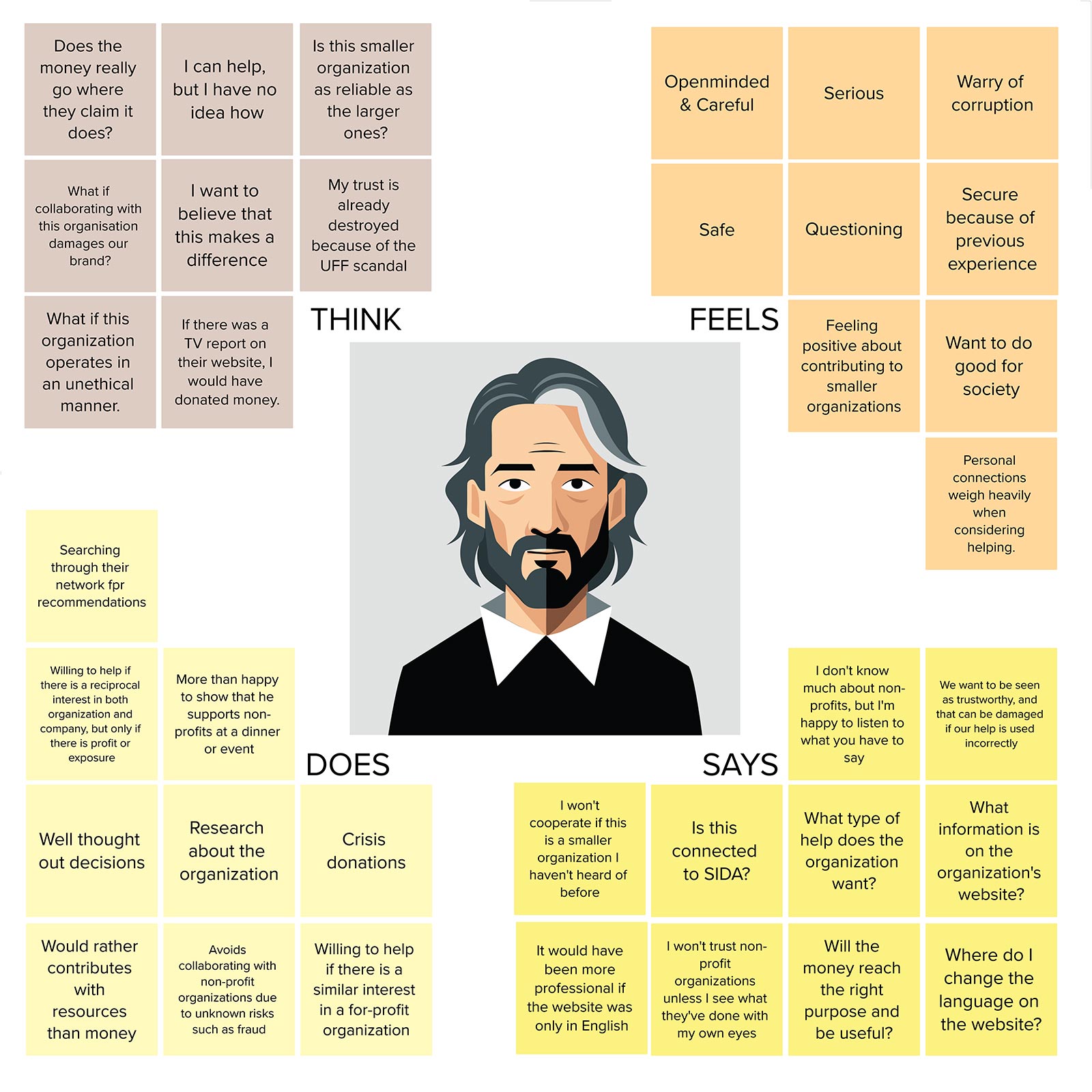
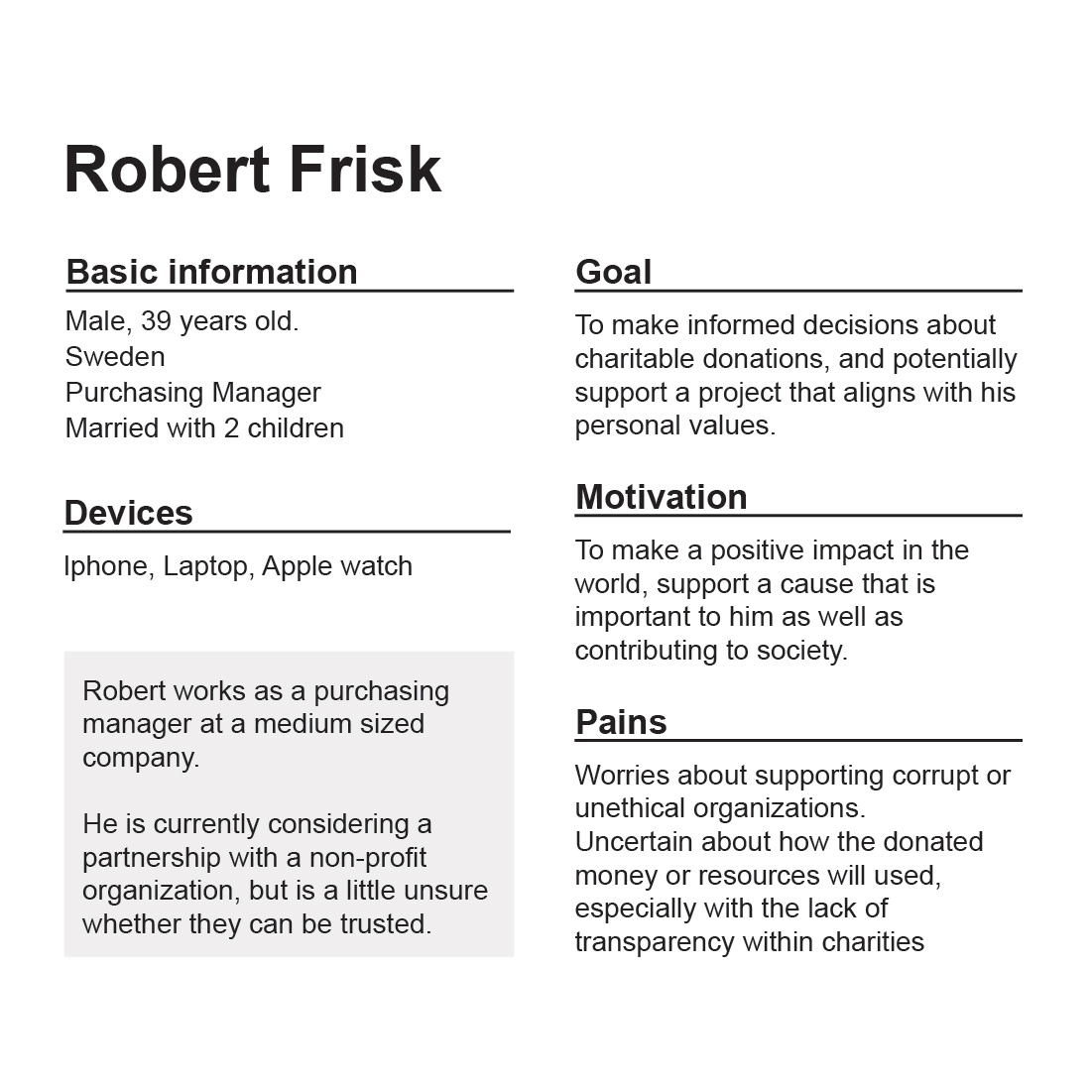
Final conclusions
So, if we are to finally try to tie everything together and answer the questions we received from Project Vita, we have concluded that references, documentation, and a 90-konto are main elements that provide safety and security for companies.
Resources and long-term collaborations are how companies prefer to conduct their charitable work.
References from previous collaborations, clear information about the organization, and possible ways to support it are important factors that companies want to see on an organization’s website.
Resources and long-term collaborations are how companies prefer to conduct their charitable work.
References from previous collaborations, clear information about the organization, and possible ways to support it are important factors that companies want to see on an organization’s website.